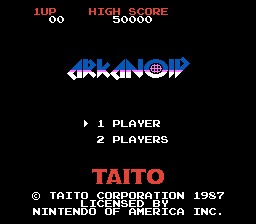 |
| Developer: Taito Publisher: Taito Released: 1987 Who Came Up With These Game Names: Arkanoid? Amagon? Astyanax? Did they just pick out of a bag of Scrabble letters? |
Since it's such an easy game to clone, other game companies rushed to copy it almost immediately after it launched. The most successful of these clones is Arkanoid, made by Taito. Arkanoid became so successful that it's almost eclipsed Breakout in popularity and notoriety.
Fun fact: The original arcade came used a trackball to control the paddle, which allowed for really great fine-grained control. It meant that if you were caught out of position, you could quickly scramble back to the right place if you needed to. I could never get the hang of the trackball myself, but my dad was awesome at it.
To Taito's credit, they didn't just copy-and-paste Breakout wholesale. In Arkanoid, breaking blocks can sometimes produce powerups, like making the paddle longer, slowing down the ball, shoot multiple balls, shoot lasers, or causing the ball stick to the paddle. There are also penalties that can be picked up, like making the paddle shorter or speeding up the ball. A good player will have to identify the powerups quickly in order to avoid getting the bad ones. Eventually, there's even a final boss, which was rare in the arcades at the time.
Like every arcade game at the time, it got a port to the NES. While the port of Arkanoid fares better than most arcade ports of the age, it's not quite perfect. For example, the fine-grained control that the trackball provided is obviously missing in Taito's NES port of Arkanoid. There was an optional controller you could buy that would try to duplicate the arcade controls, but it was very rare. While the directional pad was normally great for every other type of game, for Arkanoid, it was inexact. The ball also races around the levels at crazy speeds, which means that you'll frequently find that you've moved yourself just a little too far to the left or right and completely miss the ball.
In order to succeed, you have to force yourself not to follow the ball with your paddle but instead look at the angle of return. However, your angles can get messed up because almost immediately in the first level, you're not only breaking through blocks but also fighting off alien ships that pour through the top of the screen. No sooner that you've destroyed the ones coming in, another three or four come streaming through. Therefore, you can't just focus on the blocks at the top of the screen, but also the aliens coming after you, which frequently changes the angle that your ball returns at and catches you completely out of position.
The playable area is also very narrow, as almost 1/4 of the screen is taken up by the score, the level, and extra information that doesn't really need that much room. You have very little time to plan ahead and figure out where the ball is going to go, and since your natural inclination is to follow the ball with your paddle, and the ball moves faster than the paddle does, it can take all of two minutes to lose your lives. It really makes Arkanoid much more frantic than Breakout, as you always feel you're on the precipice of failure.
For those reasons, I wish that the first couple of levels were a little more forgiving, as it takes time to get used to the speed of Arkanoid. However, since Arkanoid came from the arcades, they had no interest in helping players along, just crushing them and taking their quarters.
Still, that frantic feeling of impending failure is actually pretty entertaining on the NES when you're not pumping quarters into a machine. Once you get the angles down and force yourself to think ahead, Arkanoid turns into a delightfully harried game that will force you to try just one more time. It certainly helps that the underlying game of Breakout invented is still fun over 40 years later. Just think of Arkanoid as Breakout in Hard Mode, and you'll have a good time.
Final Rating:
Next Week: Arkista's Ring










No comments:
Post a Comment